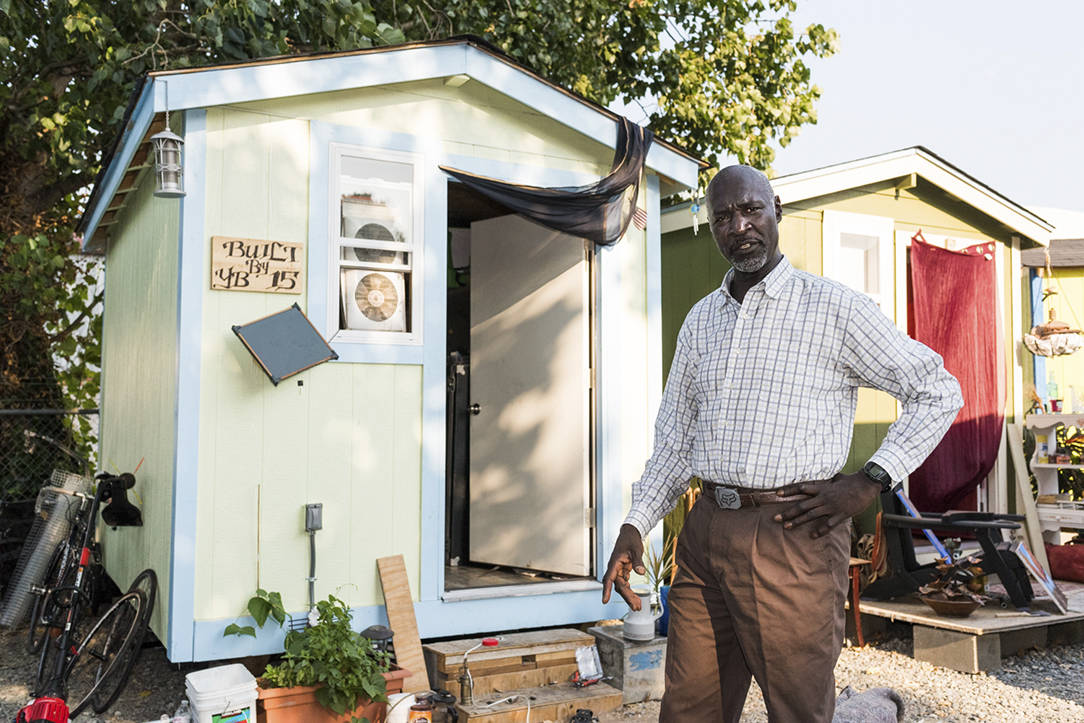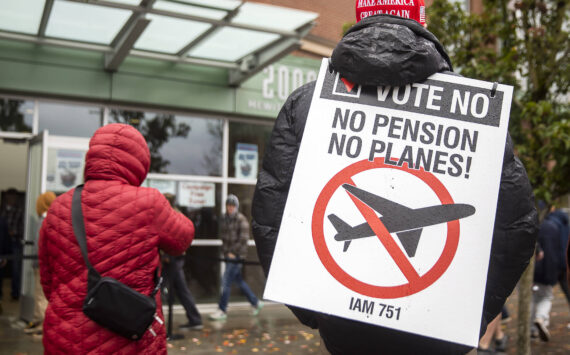Harold Odom spent almost two years living in the home he’d built with his own two hands in the woods behind St. Mark’s Cathedral on Capitol Hill. There, in a dugout with two other men, Frantic and Joe, he would listen to the footsteps of oblivious joggers overhead. “We actually had the Parks Department stand on top of us one time,” says Odom. “You couldn’t even tell we were there. They were walking on top of us, and we were listening to them, and they couldn’t find us.”
A native San Franciscan who once worked in computer repair, Odom says he’s been homeless for about a decade. “My sister died 17 years ago from complications from breast cancer, and my life emotionally started going downhill,” he says. That descent culminated in a nervous breakdown, since which “I can’t really hold things or write correctly without a struggle anymore while doing technical work for long periods of time,” he says. “I divorced and started traveling the world, from Oregon to Seattle on the train, and I got off the train to watch an interleague game between the St. Louis Cardinals and the Seattle Mariners.” He never got back on the train. When his savings ran out a few years later, he joined a camp of homeless men he knew from volunteering with the Salvation Army.
Being homeless “didn’t seem that difficult,” he says, chuckling ruefully.
The dugout was a marvel of urban survivalist MacGyvering, constructed largely out of found materials. “I had a camping book from REI that showed how to make nice little enclosures in the mountain,” says Odom. “I remember we put together the couple hundred dollars we had to get one of those sheds at Home Depot, and expanded upon it.” They covered the front entrance with camouflage netting tangled with tree branches and shoved dirt down onto the roof to make it blend into the slope. The inside was divided into three semi-private areas. “It was pretty cush,” Odom recalls fondly. He originally slept on an inflatable mattress. When that popped, Odom hung it from the ceiling as a curtain for privacy from roommates and against bad weather. The floor—made of wood pallets, with blankets and rugs on top—was sloped to help drain rain. No frills. “There’s no Home and Garden or Martha Stewart decorations for people who have to live outdoors,” he observes.
Homeless shanties are as much a part of Seattle’s modern history as logging and racial housing covenants. During the Great Depression in the 1930s, unemployed Americans in Seattle and across the country created Hoovervilles. The campers at one Hooverville, detailed in Murray Morgan’s 1951 history Skid Row, were a motley crew: loggers, carpenters, electricians, street horse conductors, longshoremen, and a “Negro” prizefighter, as well as a “missionary to the Indians,” a “young homosexual,” and a schoolteacher/dope peddler who’d also worked in sewers. The denizens, writes Morgan, “lived under the constant threat of having their homes burned again [by police] as a sacrifice to the health of the larger community.” The campers reportedly would begin rebuilding before the ashes had grown cold.
Today, Seattle authorities destroy encampments with bulldozers instead of fire, but the game of cat-and-mouse remains the same. Since declaring a state of civil emergency regarding homelessness in November 2015, Mayor Ed Murray has escalated police evictions of unauthorized homeless encampments, such as in the Jungle (where hundreds of people resided beneath and along I-5), with at least as much emphasis on suppressing encampments as on harm reduction. Murray says this encourages homeless people to accept city services and shelter. In Odom’s case, he was right. Eventually.
Yet Seattle and King County have far more people living outdoors than there are available shelter beds. Many choose not to stay at overnight shelters because of health or safety concerns like bedbugs or assault, while others don’t get a choice because their partner, pet, and/or drug use is prohibited.
Others decide that a night on a mat on the floor isn’t worth losing other shelter options that are less legal and more reliable. Every night, thousands of people sleep outside in Seattle. Most hide themselves as Odom did in his dugout (albeit less elaborately) for fear of being rousted by police. And, like Odom, many are found out, the momentary stability of shelter giving way to the search for a new home.
The precursor to Odom’s ouster was his adoption of Boxer, a barrel-shaped mutt who had been found in someone’s backyard on a three-foot chain next to a bowl of water. He was flea-bitten, and “there were scars on him when I took him to the vet. She thought I was abusing him; I said ‘No, I just got the dog!’ ” says Odom. He couldn’t afford the entire vet fee, so she gave Odom a discount.
One day Parks employees heard Boxer barking inside the dugout, and the jig was up. “They posted us” notice to leave, recalls Odom, and he and Boxer left with what they could carry. Parks staff were shocked to learn how long he’d been living there. When taking Boxer for walks past the site, Odom would see people carrying rolled-up tarps, pieces of wood, tent poles—his former home. “It took them a week to tear it down,” he says. “They were congratulating me on how nice a structure it was.”
After that, Odom moved around among different campsites until settling again at a site beneath the 520 bridge, about two years ago. Shielded from the rain, Odom says, all you “have to worry about is the water runoff. Other than that, get a nice tent and some sleeping bags and you’re set.”
However, he wasn’t the first person to live in that particular spot. “When I first moved there, I had to dig a trench, because the corner I wanted to live in, people had used it for a bathroom, and it worked its way into the dirt you were living in,” he says. And other homeless campers continued to sometimes defecate on the trail outside, he says. Soon his toes began to hurt; an infection had taken hold. He says there were no cuts on his feet—“It had just seeped into where my toenails are,” he says. He hesitated to visit a doctor, hoping that the problem would go away on its own, until one toe started oozing pus. “Then one toenail came off, and I said, ‘OK, I have to get to the hospital.’ I waited, like an idiot, not going and being stubborn.” Part of the reason he waited, he says, was because he didn’t want to go to the doctor while looking homeless. “I don’t want to go to the hospital if I’m dirty,” he remembers thinking, because he says that doctors often lecture homeless people. “It’s an amazing difference of care,” says Odom.
Meanwhile, Odom was being displaced again. When a police officer and a REACH outreach worker first visited him, “I swore at them and told them to come back later,” he says. “So they came back next month. They were persistent.”
By the time authorities coaxed him out of his hideout under the bridge, Odom’s toe infection had worsened to the point that he could no longer walk, he says. He’d already cut off the front of his own shoes, he remembers, because “the material just touching my feet was excruciating.” When Boxer laid down by Odom’s feet, “I just screamed at him,” and then felt guilty afterward.
“Before a sweep, they have an obligation to come up and offer people resources,” says Odom, “and I took those resources because I could not move.”
The eviction team helped Odom get a spot in a brand-new tiny-house village in Georgetown in mid-March, right after it opened. “We opened earlier than we were supposed to because the city was doing all these sweeps in March,” says Courtney O’Toole, 39, another camp resident and an organizer with the Seattle Housing and Resource Effort (SHARE).
“I came here because I needed foot surgery,” Odom says, referring to the Georgetown tiny-house village. In late March, about a week after moving in, Odom went to the hospital. He’d gotten hold of some clean clothes that he’d washed at the laundromat before losing mobility. As a result, he says, the emergency room staff didn’t realize he was homeless until they got around to asking for his address. By that time, he says, “they’d decided that I needed to come to the hospital because [the infection] was at the tip of my bone, so it really was a life-or-death situation.”
A surgeon amputated the tips of both of Odom’s big toes, he says. Boxer stayed in a kennel. “We didn’t see each other for almost three weeks after the surgery,” recalls Odom. “I couldn’t walk him. They wanted to make sure I wasn’t tearing any stitches out.”
On Odom’s first day back from the hospital, he had just taken a pain pill and was eagerly awaiting the return of Boxer when the Mayor of Seattle came by for lunch. Murray was scheduled to stay for only 10 minutes, but ended up sticking around to talk with campers for more than an hour. “I almost fell asleep,” says Odom, referring to the effects of the medication. “Waiting for my dog to come back … kept me awake during the meeting.”
Odom tells this story seated under the burning afternoon July sun, huddled alongside another camper beneath the shadow of the security cubicle at the front entrance to the Georgetown tiny-house village, run by Nickelsville. He wears shoes that cover his toes, and wire-frame glasses. He’s bald, black, dressed in a collared polo T and jeans. Except for a couple of missing teeth, he looks like a suburban dad.
The Georgetown village where Odom now resides broke ground on March 2 and opened its gate and doors to residents on May 15. “Almost everybody in this camp has been swept,” says O’Toole. Originally from Camas, Wash., she lived in a car with her sister and her sister’s boyfriend after her roommates lost their jobs, then followed her fiance to Seattle for work in May 2016, she says. Since then she’s lived and worked with SHARE. O’Toole was an organizer at Tent Cities 6 and 3. “When I found out that Nickelsville needed me, and the opportunity to help with the sweeps, to help the people, it was a really good opportunity for me,” she says. “So I took it. The experience of opening the camp and seeing it grow has been really cool.”
Odom’s home in Georgetown is new, but Seattle has had other tiny-house villages for nearly two years—enough time to evaluate their efficacy. In June, the Seattle Human Services Department issued a report evaluating tent cities and tiny-house villages’ performance at sheltering homeless people and getting them into permanent housing, based on information collected September 2015 through May 2017 at the Ballard, Interbay, and Othello sites (where a mix of tents and tiny houses reside). Overall, the encampments cost $755,500 in 2016, a small percentage of the $50 million the city spends on homelessness annually.
Those sites during that time period served 759 people, including 85 who went on to move into permanent housing. If you look only at those who exited to permanent housing, the cost is $8,888 per person.
People living in tiny houses tend to have better outcomes than those living in tents, because houses are nicer than tents. Residents of the mostly-tiny-houses Othello encampment were much more likely to exit into permanent or transitional housing—and much less likely to exit onto the streets, to emergency shelters, or God knows where—than residents at the Ballard and Interbay sites, which mostly and entirely comprise tents, respectively.
“The model is successfully serving people who have been living outside in greenbelts, on the streets, in cars and in hazardous situations,” the report concluded. “Overall, the neighboring communities have responded positively and there is no significant increase in crime when the permitted encampment moves in. … The success of the first two years of the permitted encampment validates the value of adding case management and services to the self-managed encampments.”
In short, the encampments and the tiny houses that partially fill them are a cheap and effective way to keep people safe and stable.
The modern encampment movement started, strangely enough, during a sporting event in the summer of 1990. It was then that Seattle hosted the Goodwill Games, a now-defunct knockoff of the Olympics created by Ted Turner. Just like at a real Olympics, city authorities tried “to some degree” to “shoo” poor people out of the city center to make room for tourists, says Joe Martin, a longtime Seattle social worker and homeless activist who sometimes volunteers for SHARE. In response, homeless activists asked for and received permission to pop up a big tent in Myrtle Edwards Park for homeless people to take refuge beneath. “Instead of people going off with their few belongings to hide under a bush, there was an effort to create a sense of community, that homeless people can successfully advocate for themselves,” says Martin.
When the games ended, so did the tourists and the impromptu encampment. But the organizing continued. “It was an experience which demonstrated [homeless people’s] capacity to advocate and get results,” says Martin. “As summer turned into fall and then winter, with the weather becoming inclement and the temperatures dropping … the decision was to take concerted action.”
One day in November of that year, a group of homeless activists stormed the mudflats south of the Kingdome, despite warnings that fire officials might intervene, according to The Seattle Times. Those officials didn’t, though, and the campers stubbornly camped. “The task of building a tent city wasn’t easy,” reported the Times. “Biting winds threatened to blow down tents, and metal stakes and sledgehammers were not available.” Within days the camp’s numbers had swelled to 166 people. “After the place was set up, people just started showing up because the need was out there,” says Martin. “ ‘If you build it, they will come,’ you know? It was dramatic.”
“We are bending over backward to let this go on for a short period of time,” but not indefinitely, a spokesperson for then-mayor Norm Rice told the Times. By December, the city and campers had negotiated a move to an out-of-use Metro bus facility. “It’s over with and I’m glad we’re getting out of here,” one camper told the Times with a grin. “We’re going inside where it’s warm and there are showers. We can breathe again.”
In the 27 years since, SHARE and its progeny have taken up the administration of several indoor shelters and tent cities, including the Georgetown tiny-house village, where Odom now lives. The growth of SHARE’s size and influence in alliance with local churches and nonprofits has been gradual and contentious, full of both legal action and direct action. In 2002, then-city attorney Tom Carr reluctantly signed paperwork formally permitting tent cities hosted by churches. In 2011, the City Council passed legislation making it even easier for churches to support these sites.
While mayor, Mike McGinn tried to increase the number of permitted tent cities, but the City Council (with the support of then-candidate Ed Murray) put the kibosh on that idea. The following year, at a task force’s behest, Murray decided that more tent cities were a good idea after all, and used the failed 2013 legislation as the basis for his own similar proposal. According to that task force, “small houses” in authorized homeless encampments could “create alternative housing options for people who are homeless” and “define [a] path from encampment community to transitional/subsidized housing.” With McGinn out of the picture, Murray doing the asking, and Kshama Sawant newly elected to Richard Conlin’s former Council seat, the city legislature’s more conservative members changed their minds, too, and by 2015 city-sponsored tent cities had opened in Ballard and Interbay. Four more would follow, first in Othello and later at Myers Way, Licton Springs, and Georgetown, where Odom would eventually find his tiny home.
As their name implies, the tiny houses are small: 8 feet by 12, elevated a few feet above the ground by concrete blocks. “When we get them—two windows, four walls, and a door—it’s nothing,” Odom says. Each house comes with wooden front steps and electricity. There’s running water in the communal kitchen in the big tent, as well as cooking and baking facilities. The lot is covered in gravel and surrounded by a chain-link fence.
Tiny houses as a “small-scale housing” solution to homelessness, as Murray’s 2014 Emergency Task Force on Unsheltered Homelessness put it, were inspired in Seattle by previous examples in Olympia and Portland. Camp Quixote began on February 1, 2007, as a protest against a new Olympia law that prohibited sitting, lying down, or asking for money. The camp survived for several years until Christmas 2013, when campers shed their tents and founded Quixote Village, a tiny-house village, with assistance from Panza, a nonprofit formed for that purpose. According to The Olympian, each of the 30 tiny houses in this sober community occupies 144 square feet and comes with a closet, front porch, half-bathroom, bed, electricity, and heat, and each camper shares communal access to a kitchen, showers, mailboxes, and a laundry room. The village cost about $3.05 million to establish, according to the task force. Portland’s Dignity Village similarly began as a protest encampment in 2000 and now has 60 tiny houses, built mostly out of recycled materials by residents.
Four months after surgery, the stubs of Odom’s toes have mostly healed. In place of the camouflage of the dugout and other illicit campsites, the front of Odom’s house is covered with a portable solar panel, a mosquito net hanging over the doorway, a carved wooden sign with the builder’s initials, and a tiny American flag. Plants grow in pots on the wood steps. He’s got cucumber and an indoor ivy plant. “I have chocolate mint,” brags Odom. “I just knock it once in a while to give off its smell.” His clothes and books sit on clean shelves. A portable air conditioner sits in the open front window, humming. Out front, Boxer waddles by his water bowl, lazily searching for nuzzles beneath the shade of the giant trees overhead. Inside is a nice oak coffee table, says Odom. “I entertained somebody and we dined on it.” In the oven in the village’s communal kitchen, Odom bakes raisin bread.
It’s not perfect. Some days, Odom can hear his neighbors screaming at each other from the other side of the lot. The site is in the middle of an industrial wasteland, all the buildings made of squat cement blocks and rusting metal girders. But for Odom, this is home. In the evening, he sits on the wooden steps that serve as a front porch, scratching Boxer’s head absentmindedly in the waning sunlight.
He says he’s looking for work. He plans to live on a boat, 35 feet long at the most. He says he’s willing to put in 30 hours of labor a week for however many weeks as a down payment. Moorage is cheaper than rent, he says. He’ll put down non-slip paper on the deck so that Boxer doesn’t slide off it into the water.
So many plans. “Five months ago, I had different priorities. My outlook was just survival then, keeping my dog warm and safe,” he says. “Now I have a different set of short- and long-term plans. I’m looking for a part-time job and a place to live.”
cjaywork@seattleweekly.com
This post has been updated to note Sawant’s involvement in the origin of city-sponsored homeless encapments.








